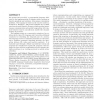93 search results - page 18 / 19 » Using conflict theory to model complex societal interactions |
GECCO
1999
Springer
13 years 9 months ago
1999
Springer
This paper discusses the simulation results of a model of biological development for neural networks based on a regulatory genome. The model’s results are analyzed using the fra...
PPDP
2005
Springer
13 years 11 months ago
2005
Springer
We present ReactiveML, a programming language dedicated to the implementation of complex reactive systems as found in graphical user interfaces, video games or simulation problems...
EMSOFT
2004
Springer
13 years 10 months ago
2004
Springer
Embedded devices like smart cards can now run multiple interacting applications. A particular challenge in this domain is to dynamically integrate diverse security policies. In th...
AAMAS
2005
Springer
13 years 5 months ago
2005
Springer
Cooperative multi-agent systems are ones in which several agents attempt, through their interaction, to jointly solve tasks or to maximize utility. Due to the interactions among t...
CHI
2007
ACM
14 years 5 months ago
2007
ACM
We present the case study of a complex, mixed-initiative scheduling system to illustrate Work-Centered Design (WCD), a new approach for the design of information systems. WCD is b...


